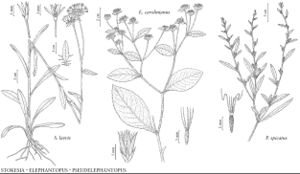Elephantopus
Sp. Pl. 2: 814. 1753.
Gen. Pl. ed. 5, 355. 1754.
| Taxon | Illustrator ⠉ | |
|---|---|---|
 | Stokesia laevis Elephantopus carolinianus Pseudelephantopus spicatus | Bee F. Gunn Bee F. Gunn Bee F. Gunn |
Perennials, (1–) 2–8 (–12+) dm; often rhizomatous or stoloniferous. Leaves mostly basal or mostly cauline at flowering; sessile or petiolate, petioles ± winged (often clasping at bases); blades mostly elliptic, ovate, or obovate to lanceolate, oblanceolate, or spatulate (rarely orbiculate), bases ± cuneate, margins usually toothed (rarely entire), apices obtuse to acute, abaxial or both faces usually resin-gland-dotted. Heads ± discoid, sessile, not individually bracteate, in clusters of (1–) 10–40+ in corymbiform-paniculiform arrays 6–15 (–25) cm diam. (each cluster subtended by 2–3 ± deltate bracts). Involucres ± cylindric, 1–3+ mm diam. Phyllaries 8 in 4 decussate pairs, the outer 4 ovate, inner 4 lanceolate, all ± chartaceous, margins entire, tips ± spinose to apiculate, abaxial faces of inner 4 usually dotted distally with resin-glands. Florets (1–) 4 (–5+); corollas white or pink to purple, tubes longer than abruptly funnelform throats, lobes 5, lance-linear, unequal (abaxial sinus deepest). Cypselae ± clavate, sometimes ± flattened, 10-nerved or ribbed, strigillose to hirsutulous; pappi persistent, of 5 (–6), 1-aristate scales (look closely for squamiform, gradually to abruptly tapering base of each arista). x = 11.
Distribution
Mostly warm-temperate, subtropical, and tropical regions worldwide, sometimes as naturalized ruderals
Discussion
Species 12–15+ (4 in the flora).
Pseudelephantopus spicatus is sometimes treated as a member of Elephantopus.
Selected References
Lower Taxa
Key
| 1 | Leaves at flowering all or mostly cauline | Elephantopus carolinianus |
| 1 | Leaves at flowering mostly basal (cauline leaves much smaller or wanting) | > 2 |
| 2 | Inner phyllaries 9–11+ mm; pappi 6–8 mm | Elephantopus tomentosus |
| 2 | Inner phyllaries 6–8 mm; pappi 3–4.5 mm | > 3 |
| 3 | Inner phyllaries ± densely strigose-villous with hairs (0.3–)0.5–1 mm; cypselae 3– 3.5 mm | Elephantopus elatus |
| 3 | Inner phyllaries sparsely strigose or hispidulous with hairs 0.05–0.3(–0.5) mm; cypselae 2.5–3 mm | Elephantopus nudatus |
"dm" is not declared as a valid unit of measurement for this property."dm" is not declared as a valid unit of measurement for this property.